
Editorial
|
Fragments
|
Aztalan
|
Carpet Rocks
|
Sphinx I
Register
for our Hall of Records Newsletter!
Questions? Comments? Suggestions? Advertising? Press Releases?
Contact us!
The Pyramids of Wisconsin
|
The Lost Pyramids of Rock Lake
|
Map


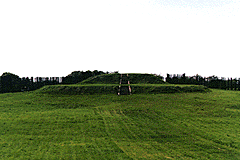
|
|
The main mound at Aztalan, comprised of two basic levels. The main mound is one of three primary
mounds (two of which have been restored), and numerous smaller mounds. Many of these mounds had
been destroyed and cleared to make way for farming, resulting in untold losses in archaeological
data. Aztalan was finally rescued by archaeologists and the State of Wisconsin earlier in this
century. The stairs seen here have been added to show where the original stairs were positioned.
|
|
 here is an ancient mystery in southern Wisconsin. And, although this curious anomaly
has been studied for more than a century, some intriguing questions remain. The mystery
came to light in 1835 when pioneers settled the south-central part of the state. There
they discovered the remains of three flat-topped pyramidal mounds and many smaller
artifacts scattered throughout the surrounding area. Initially, settlers referred
to the three truncated earthen pyramids as the "Ancient City." Soon thereafter, however,
Nathaniel F. Hyer, a judge from Milwaukee with an interest in ancient matters, re-named
the site "Aztalan" because of its resemblance to a place described
in an Aztec legend.
here is an ancient mystery in southern Wisconsin. And, although this curious anomaly
has been studied for more than a century, some intriguing questions remain. The mystery
came to light in 1835 when pioneers settled the south-central part of the state. There
they discovered the remains of three flat-topped pyramidal mounds and many smaller
artifacts scattered throughout the surrounding area. Initially, settlers referred
to the three truncated earthen pyramids as the "Ancient City." Soon thereafter, however,
Nathaniel F. Hyer, a judge from Milwaukee with an interest in ancient matters, re-named
the site "Aztalan" because of its resemblance to a place described
in an Aztec legend.
Hyer may have been influenced by the work of Alexander von Humboldt, a noted German explorer
of that time. Von Humboldt, while studying the history of the Aztec nation, had discovered
a legend which indicated the ancestors of the Aztecs had come from a land of flowing waters
far to the north of their home in Mexico. It would have been obvious to Hyer that Wisconsin,
with its many rivers, was like the place in the legend. And Aztalan, with its pyramids, may
have seemed the prototype of an Aztec city.
Since 1835, archaeologists have learned that the people of Aztalan may have been related
to the inhabitants of Cahokia, a similar but much larger settlement in southwest Illinois
across the Mississippi River from St. Louis.
(Cahokia will be featured in the Spring 1999 issue of Mysterious World).
Further research has revealed that at one time
Aztalan covered 21 acres and had a population of approximately 500.
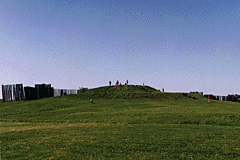
|
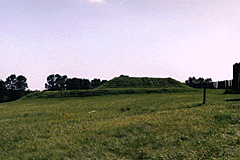
|
|
The main mound again, looking northwest (left) and south (right).
|
Aztalan was surrounded by a high log fence which included watchtowers at regular intervals.
Within the fenced area were three pyramids, houses and cornfields. Two of the pyramids,
a substantial portion of the fence, and several watchtowers have been restored. One of the
restored pyramids, a single-level mound, is in the northwest corner of the site. The other,
a multi-level stepped mound, is in the southwest corner. The mounds appear to have been
constructed to serve ceremonial and political purposes. The log fence and watchtowers
probably served to separate the community from unrelated people groups in the area and to
provide a place of refuge in case of attack.

Sauk Native Americans speak in their legends of a sacred site close by a lake.
The Sauk did not construct the site and related structures - this was done by
ancient peoples who were driven away when the lake flooded. Stories have
continued to the present concerning Rock Lake "pyramids" and other underwater
foundations.
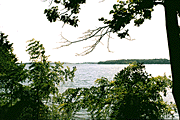
|
Lake Mills, or "Rock Lake"
|
The "pyramid" legends were revived during the mid 1930s when a combination of
low water and clear, dry summers allowed viewing of a number of subsurface
geometric forms including pyramids, cones, walls, and trenches. One individual
Max Knoll, using his own invention - a form of SCUBA dive gear - dove the lake
and viewed many of these structures. Still, those who supported the theory of
man-made underwater structures were ridiculed and little was proved either way.
Interest in the structures was renewed when observations of SCUBA divers were
published in the 1960s. A major effort commenced in the 1980s with a complete
side scan sonar study of the lake floor showing a number of unusual-shaped
structures along a submerged beach.
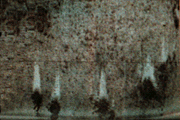
|
Side-scan sonar reading, indicating several artificial structures beneath
the surface of Rock Lake.
|
Unusually clean water conditions in 1991-92
allowed two of the sites to be photographed in sufficient detail to prove their
existence as man-made structures. Sufficient evidence does not exist to date the
structures or to identify their builders. One possibility is that they are
associated with prehistoric copper trade cultures which would coincide with the
Post Algoma low lake levels of 3,000 years ago. Future research will hopefully
tell us more about these ancient visitors and their contributions to Wisconsin
heritage.
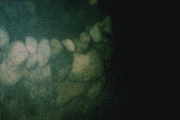
|
|
Photograph of one of the underwater structures, clearly indicating stacked, fitted rocks, arranged in a circle.
Text and photos by Lloyd Hornbostel
Lake Mills, WI
|
|
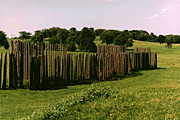
The "stockades" surrounding the main Aztalan complex. These logs were put in place to simulate the relative positions
of the walls surrounding the central acropolis, using the original post holes dug by the original inhabitants.
|
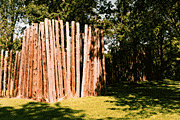
A closeup of one of the guard towers. The spaces in between the posts were originally filled in with rock and other matter,
most of which has since been destroyed or used for other purposes.
|
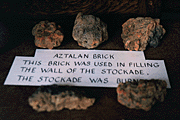
Examples of the "Aztalan brick" the original inhabitants used to fill in the spaces between the posts.
|
The people of Aztalan were, in some ways, more advanced than others living in southern
Wisconsin at the time and, thus, may have felt superior to them. In that regard, it is
possible that Aztalan subjugated some of its neighbors and demanded tribute from them.
Aztalan was last occupied sometime between 1100 and 1300 A.D. There is evidence of extensive
fire there at the time of its abandonment. Although the reason for its destruction is
unclear, one possible explanation can be found in the subsequent experience of the Aztec
people.
The Aztecs occupied the Valley of Mexico and surrounding areas for about three centuries. They
dominated this region and extracted tribute from its subject peoples until they were defeated
by the Spanish in 1521. It should be noted that the Spanish were victorious because of their
alliance with thousands of people in eastern Mexico who had been subjugated by the Aztecs and
wanted freedom from their rule. It is possible that the power of Aztalan also was broken by
an alliance of subject peoples in southern Wisconsin seeking freedom from its control.
If the people of Aztalan were driven from the region by more powerful forces, it is likely they
sought safety in some distant place. In that regard, it may be more than a coincidence that
Aztalan was abandoned in the same era that the ancestors of the Aztecs entered Mexico from the
north. If the survivors of Aztalan migrated far enough to the south, they may, indeed, have
been among the ancestors of the Aztecs ... and the legend may be true!
* * *
Although much has been learned about Aztalan since its discovery, the full story of that ancient
city is still unknown. And, until someone with the right combination of curiosity, drive, and
luck discovers what really happened there, the pyramids of Wisconsin will remain a mystery.
* * *
Whatever the truth of Aztalan's past, it is an interesting and pleasant place to visit now.
It can be found in a peaceful rural setting near a wide river that flows between gently rolling
hills dotted with groves of trees.
The pyramids and surrounding acres became the Aztalan State Park in 1948. The park and adjacent
Aztalan Historical Museum are about 20 miles east of the Wisconsin's capital, Madison, and some
three miles east of the city of Lake Mills. While the park and museum can be reached from more
than one direction, the easiest way for some may be via Interstate 94 to Highway 89 and then
south into Lake Mills. From there it is only a few minutes drive east on Jefferson County B and
then south on County Q.
The park is open from May to October between 7 a.m. and 9 p.m. The museum is open from May 15
through September 30 from Monday through Saturday (10 a.m. to 4 p.m.) and on Sunday (12 noon
to 4 p.m.). There is a nominal fee to enter the museum complex which houses prehistoric
artifacts from the area and includes several pioneer buildings furnished with relics from
the historic period.
* * *

|
|
A 360-degree view of the Aztalan acropolis, from the lesser, northern mound.
The primary pyramidal mound can be seen near the right side of the photo.
(Click
here
to see a larger version.)
|
The Pyramids of Wisconsin
|
The Lost Pyramids of Rock Lake
|
Map
Editorial
|
Fragments
|
Aztalan
|
Carpet Rocks
|
Sphinx I
Register
for our Hall of Records Newsletter!
Questions? Comments? Suggestions? Advertising? Press Releases?
Contact us!
For more information about Aztalan, please refer to the following sources:


AAA Michigan/Wisconsin Tour Book. Heathrow, Florida: AAA Publishing, 1997.
Austin, H. Russell. The Wisconsin Story. Milwaukee, WI: The Milwaukee
Journal, 1948.
Aztalan Historical Museum/Aztalan State Park. Wisconsin Department of
Natural Resources, February 1991.
Childress, David H. Lost Cities of North & Central America. Stelle, IL:
Adventures Unlimited Press, 1992.
Folsom, Franklin. America's Ancient Treasures. New York, Chicago, San
Francisco: Rand McNally & Company, 1971, 1974.
Hintz, Martin and Dan Hintz. Wisconsin Off The Beaten Path. Chester, CT:
The Globe Pequot Press, 1989.
Jefferson County Visitors Guide. Jefferson, WI: n.p., 1993.
Ritzenthaler, Robert (Editor). "Aztalan: Exploration and Reconstruction."
The Wisconsin Archaeologist, Vol. 39, No. 1 [Milwaukee], March 1958.
Schultz, Helen A. (Editor). The Pioneer Aztalan Story. Lake Mills, WI:
Lake Mills - Aztalan Historical Society, 1969.
The World Book Encyclopedia, A - Volume 1. Chicago: Field Enterprises,
Inc., 1973.
Will, Tracy. Wisconsin. Oakland, CA: Compass American Guides, Inc.,
1994, 1997.
|

